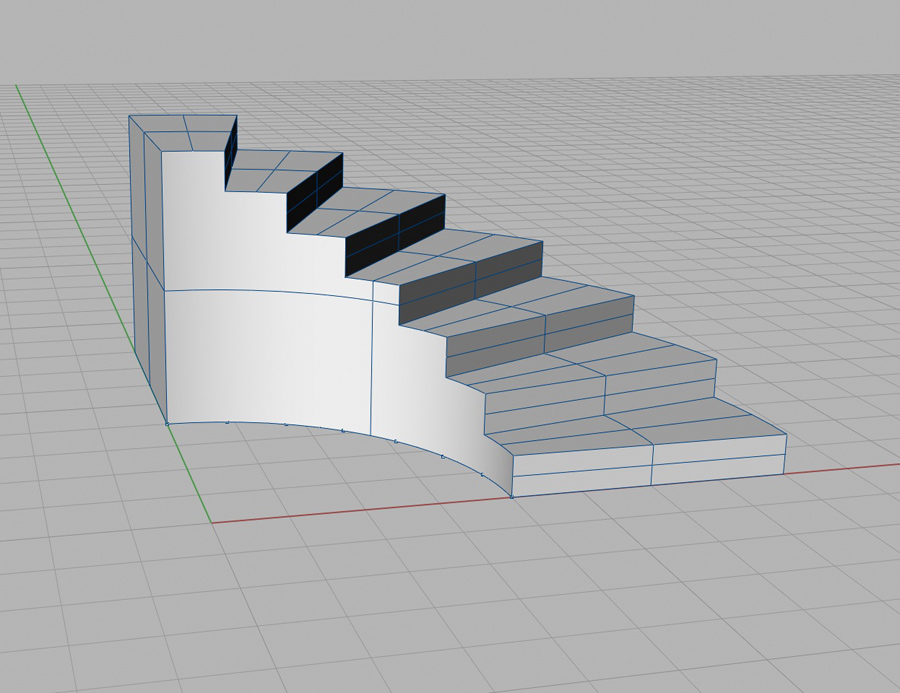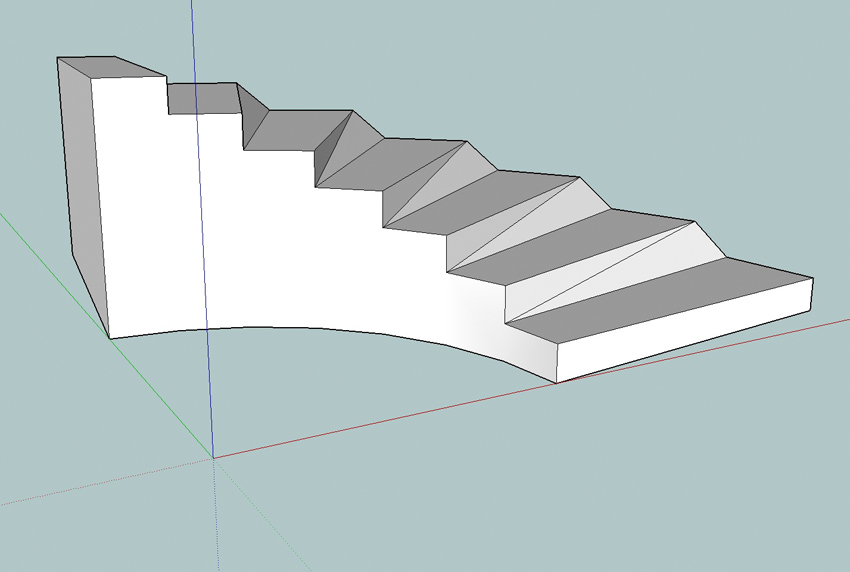2D curve wrap to surface cylinder-best method?
-
Dale,
Sorry, but your example doesn't work really. the stringer generated is narrow in the middle and wide (taller) at the top and and ---well, there are a bunch of other issues.I actually use the geometry of cylindric sections often in my work, but re. SU and what I'm trying to accomplish with it,---that's not the answer.
-
@dale said:
If we decide on a 10" run, then the angle can be calculated to 37.6 degrees.
thing is, if you intersect a plane with a cylinder as you've shown, the only place that angle will actually be 37.6 degrees is exactly at the point of perpendicular contact (on a radius line of the cylinder).. everywhere else on the cylinder, the angle will change..
this skp might show the problem better than i can explain with words.
.
-
@volutes54 said:
Simple helix is not a problem. The issue is creating transitions between helixes of different pitches.
that picture helps but just to be clear, when you say 'helixes of different pitches', are you meaning the radius (top view radius) changes..
when i read pitches earlier, i thought you were talking about changes in steepness (as in roof pitches) which was(is) confusing..
i don't think you're building stairs that have a 7" rise for a little bit then they switch to 9", right? -
Of course,
 Thanks.
Thanks.
Are we actually talking about an elliptical helix? -
Actually the pitch may change because there is a transition from straight treads to winders, which shortens the run of the tread relative to the rise (which does stay constant).
And some stairs are nominally "elliptical" in that while their plan may not be described as a true ellipse, one portion will have a broad radius and other sections will have a tight radius.
Jeff, there are many "elliptical" plan stairs in those old Manhattan and Brooklyn brownstones in your area.
The stringer of the stair shown in the accompanying photos varies in pitch and plan radius. The upper treads are straight and have three baluster. The lower treads are two baluster per--, and the lower end at handrail volute tightens into shorter radius. Yes the upper portion of the stringer is straight in plan, but a smooth transition was made into the steeper curved section. The second photo illustrates the sort of curve that might be developed on a cylindric surface.
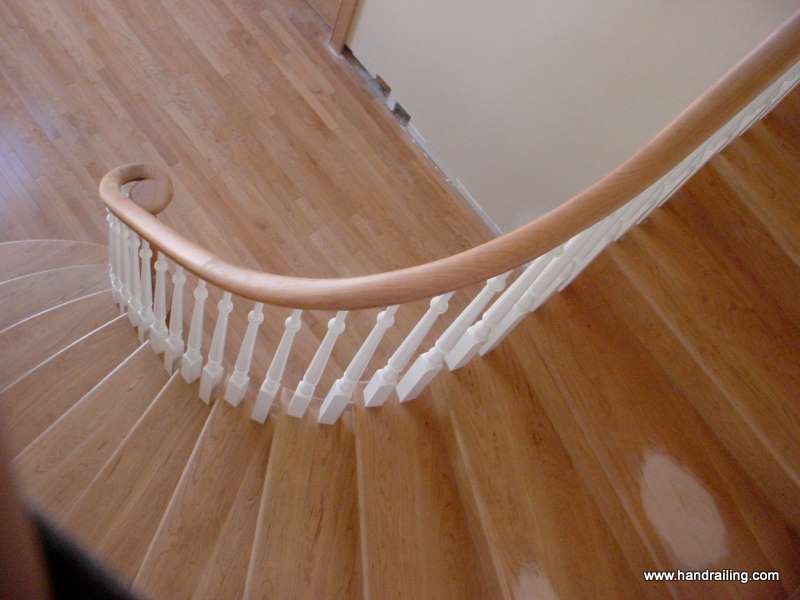

-
and another view from the side
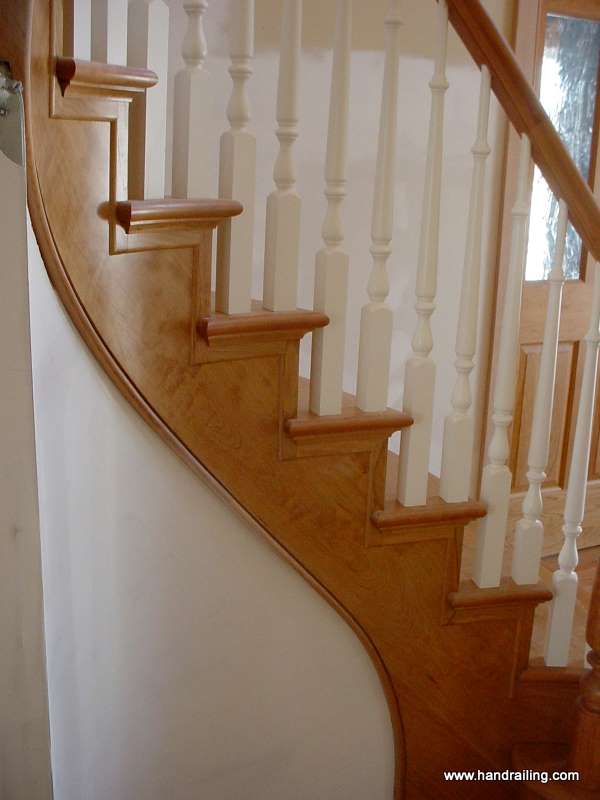
-
@volutes54 said:
Actually the pitch may change because there is a transition from straight treads to winders, which shortens the run of the tread relative to the rise (which does stay constant).
And some stairs are nominally "elliptical" in that while their plan may not be described as a true ellipse, one portion will have a broad radius and other sections will have a tight radius.
Jeff, there are many "elliptical" plan stairs in those old Manhattan and Brooklyn brownstones in your area.
The stringer of the stair shown in the accompanying photos varies in pitch and plan radius. The upper treads are straight and have three baluster. The lower treads are two baluster per--, and the lower end at handrail volute tightens into shorter radius. Yes the upper portion of the stringer is straight in plan, but a smooth transition was made into the steeper curved section. The second photo illustrates the sort of curve that might be developed on a cylindric surface.i'm on the top floor of my brownstone (in brooklyn) and have 2 really sweet 100+yr old staircases to navigate every day..
 (probably very similar to what you're trying to draw)
(probably very similar to what you're trying to draw)and now that i think of it, a spiral staircase can change pitch simply depending on if you're walking up the inner or outer edge of the thing.
i've gotta get ready to go out but i'll post back later with some ideas.
-
i took a stab at drawing the stairs in your pictures.. i stopped before getting too detailed (no risers, routed edges, railings etc.) but i'm wondering if anything in the drawing is what you're trying to do? if so, i can show you what i did for that part (and actually, once i nearly finished this, i thought up a different method that i could probably do a lot quicker)
i just guessed at the dimensions and tried to get as close to what's happening in the picture as i could see but i think another angle or two would help.. if these are drawn more or less to the proper shape then i would forget about a plugin for drawing a lot of it.. there's just too many weird little things happening in there for a plugin (i think?)i used mostly the line tool and other vanilla sketchup tools for this. (no cylinders though)..
plugins used were:
select curve
weld
extrude edge by vector (this is one that i'm sure you'll find a use for)
a little bit of extrude edges by rails for the bottom of the stringeranyway, i may have found a way to draw them a bit faster but not by much.. (unless it takes you 2+ hrs to draw this much.. then i found a time saver for you)

-
Jeff,
Excellent! The element that I've had trouble with is the stringer ---ie. the side of the stair below the inside radius tread ends. I need to upgrade my SU to v.8 in order examine your model more closely. I'll do that later this today.
-
Like Jeff I couldn't leave this alone,so also tried to replicate from the photo.
The problems I had were similar to ones you mentioned earlier in the Tools on Surface just wanted to make these random lines that seemed to go to some theoretical centre.
When I am doing designs for guitars I have to scale up in order to do some of the work on the neck as it seems to want to leave out some of the triangulation, so you don't get a selectable face. That's what I did here although I still had one line I could not erase without deleting part of the face. I scaled up by a factor of 10, but I think going even bigger would be better.
Used TOS, and Joint Pushpull.
By the way, visited your website, you do some very fine work.
Cheers
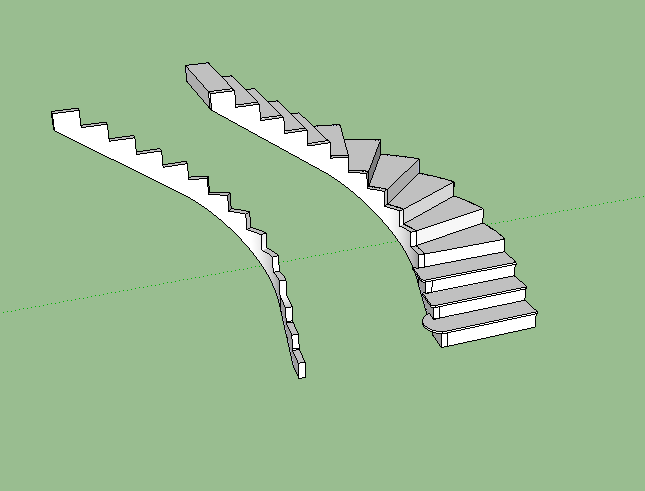
-
By the way, here a link to a cool little spreadsheet for helix calculation. It contains cost components as well.
http://www.woodweb.com/software_downloads/formulas_spreadsheet.xls
I really like the springback calculator, and have used it in guitar mold making. There is also a crown molding
calculator and various other nice applications. -
Just checking in quickly.
Dale, I had wondered if scaling up would help out with the Tools On Surface. The specific element I was attempting to draw was a flare in the stringer at the bottom. ---quite small compared to the rest of the stair. ----and exactly the sort of thing that needs to be worked out for the design approval of a client.
I haven't opened Jeff's file since I'm still using SU 7.0 Pro. Is yours in 8.0? I'm reluctant to upgrade because my video card is about about maxed. It looks like you've have good results also. I may see if they have a viewer.
This dialogue has been--and continues to be very helpful. Jeff mentioned he had some additional thoughts on drawing strategy. I'm looking forward them.Thanks for the spreadsheet link (and your compliments on our work)--- I'll definitely check it out.
I'll check in later
Dan B. -
Dale,
re. the springback calculator----- glad to hear it has worked for you, but we've found it's not infallible. -
Dan
Here is the skp 7.. Jeff can probably save his as a skp7 for you as well, his looks a little more elegant than mine.Springback is always challenging. I used to have a lot of fun with curved doors. I think it may be like getting good sound from an acoustic guitar, there's some luck and a little bit of voodoo.
-
here's a step-by-step of how i'd go about drawing these stairs.. (and i'm assuming this might not be much help to you dan as you can probably already draw this stuff and are looking for a more automated method)
i know of some way easier/faster ways to do this if i were just trying to get something to look right but i approached them as if i were going to actually build the set.. (and there are still plenty of things that would need to be drawn or reworked prior to building them.. if i were really going to build this set, i bet i'd end up drawing them 4 more times before i was ready to make sawdust.. with my own work, i can do things first try as i'm way more familiar with what's going on and all of the little nuances etc.)but yeah, i usually draw the more complex stuff i build in a similar manner as shown here.. thing is, i'd rather spend a few extra hours on my computer working through the problems instead of onsite scratching my head and wasting materials.. plus, if you can really draw the stuff accurately, it's much easier to have someone else do all the work while i sit around on site drinking coffee and listening to the ipod

honestly though, sketchup isn't exactly perfect for drawing things like this.. (compound curves etc.) it's ok for single curves and the segmentation can be dealt with rather easily (and in some cases, to your advantage).. it's when you need to bend something then bend it again in a different direction when the headaches come into play.. i've started using rhino lately for the compound bends and really, it's way better/faster/easier/more accurate for this type of stuff.
here's a SU 7 file.. click the scene tabs up top to go through the process..
[i'd definitely be interested in seeing a better way and i'll see if i can come up with something else too]

-
-
Well this has turned out to be a very informative thread.
Jeff are you using Vector Pushpull? I am just using JPP , and attached the file for perusal. The only difference I can see in our methods is I used the inner radiused shape as the stringer surface. In this file I just randomly Joint PushPulled to 4'9 or thereabouts.
However I am not getting the same results(see attached jpeg and skp.) as my rises and runs are maintaining 90 degrees.
I do agree that Rhino (and Blender) probably does a better job and have often wanted to break down and learn it. How is the learning curve by the way?(no pun intended)
I did a little research on JPP, and apparently if the curves get too complex the geometry will intersect itself, which is probably why I have a line I can't delete without removing part of the face.
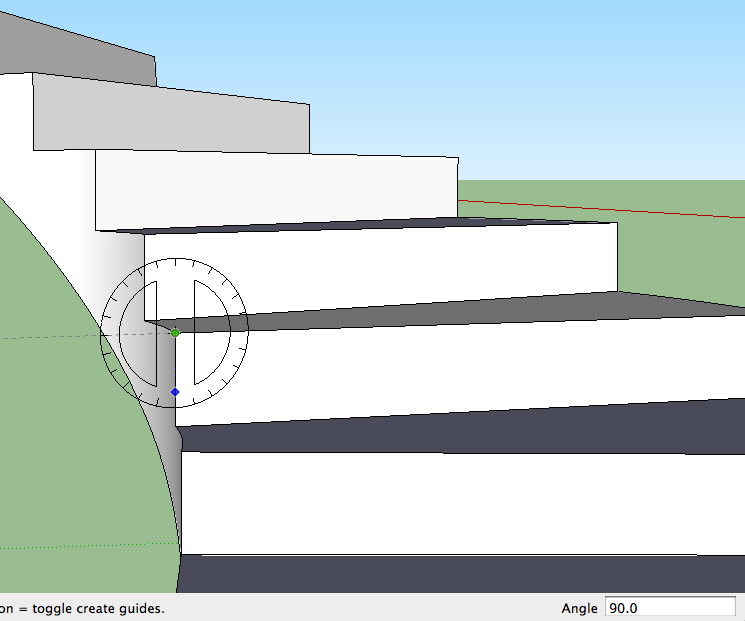
-
@dale said:
Well this has turned out to be a very informative thread.
Jeff are you using Vector Pushpull? I am just using JPP , and attached the file for perusal. The only difference I can see in our methods is I used the inner radiused shape as the stringer surface. In this file I just randomly Joint PushPulled to 4'9 or thereabouts.
However I am not getting the same results(see attached jpeg and skp.) as my rises and runs are maintaining 90 degrees.hey Dale,
it's the other side where the error occurs (the resulting offset stringer will be messed up).. since you have so many segments, you might have to exaggerate the jpp to 50' or so until the error becomes obvious.i did notice one thing about your file/jpp.. in the areas where your riser falls in between two segments, the offset will work ok.. when the segment is in vertical alignment with the riser, the operation will fail.. (but, that's a catch22.. if your building curved things using segmented arc drawings then all key intersections have to be a vertex or it won't be accurate)
further, the problem isn't really that the resulting offset stringer ends up with nonvertical risers, that just highlights the problem.. the real problem when offsetting in sketchup is due to the fact that arcs/curves are segmented.. in the rhino/su comparison i posted above, ignore the stairs and only look at the bottom of the geometry.. the rhino pic shows a 90deg arc which when offset, maintains the 90 degrees (look at the axis/grid lines).. the sketchup offset comes off the axis even though it's a 90 degree arc to begin with.
[using the above 90 degree arc example] sketchup has no way of knowing that the end segments of an arc are actually supposed to be perpendicular to the radius.. instead, the end segment is placed at a weird angle and that segment is what ends up being offset..
@unknownuser said:
I do agree that Rhino (and Blender) probably does a better job and have often wanted to break down and learn it. How is the learning curve by the way?(no pun intended)
it's not easy.. (but then again, a lot of people say how easy SU is to learn but in my case, it took me a few years until i really understood the ins and outs of it).. but, if you continually find sketchup failing in certain aspects that you need it to perform in, then you really have no choice but to look elsewhere.. same thing if you had to apply textures to curved surfaces all day long.. using sketchup for that doesn't make too much sense..
@unknownuser said:
I did a little research on JPP, and apparently if the curves get too complex the geometry will intersect itself, which is probably why I have a line I can't delete without removing part of the face.
well, it's not joint push/pull that is failing here, it's sketchup itself.. this same error that i'm trying to point out with the offset tool occurs over and over throughout sketchup with other functions as well (follow-me does the same thing).. joint push/pull is simply using the sketchup engine but does multiple offset operations at once.. using it, you can see a whole bunch of errors at one time but the same thing would happen if you used native sketchup offset tools and drew it step-by-step
-
.
click pic for larger
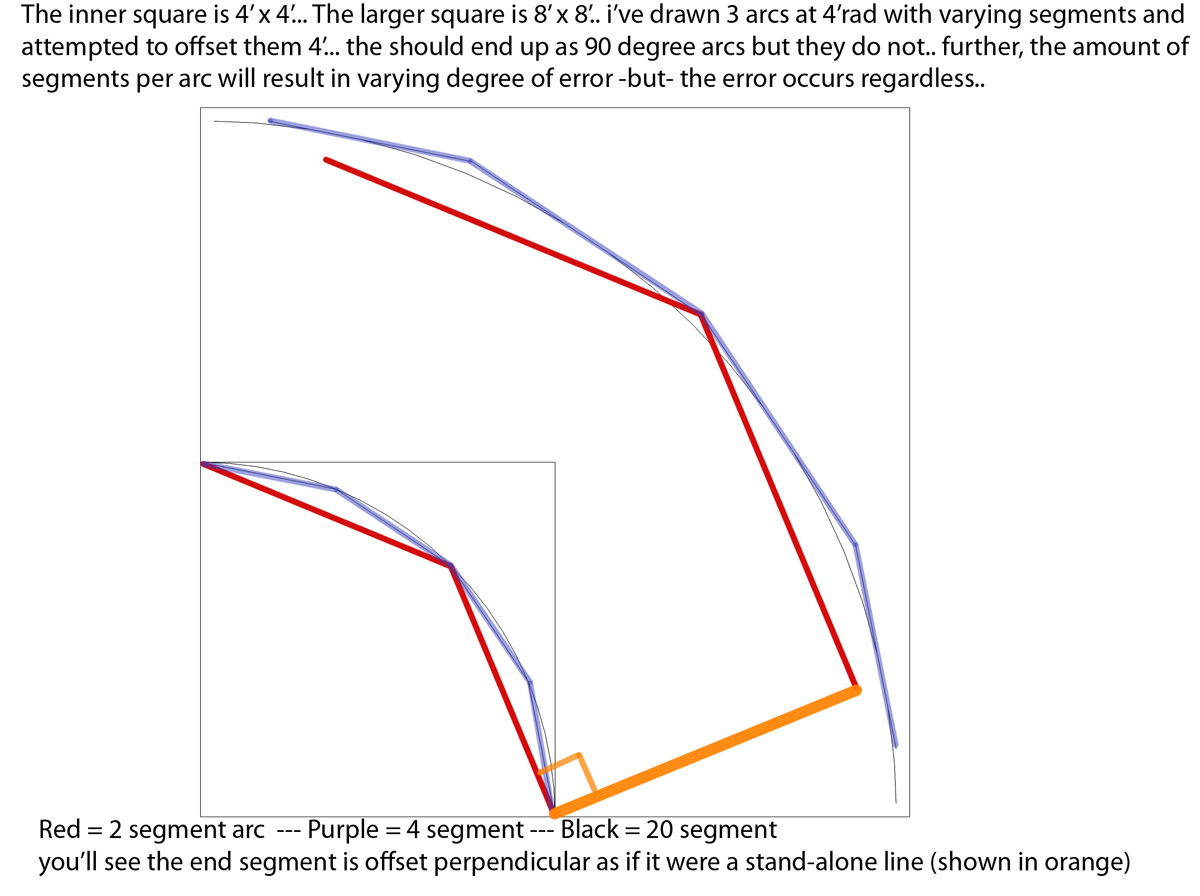
-
Jeff
Thanks for the detailed explanation.So in reality, if you are using Sketchup to "represent" objects, to give the impression of what they will look like, then you can accomplish that. And probably your clients will be happy.
But, if you are going to require the accuracy to build these objects, or send them to cad/cam then the way SketchUp handles geometry means it just won't always work. (in particular with curved geometry).Since part of what I do is ArchVis I guess I can fudge it, but I have been getting frustrated with the results of complex geometry drawings lately.
I know a fellow who has a really sweet computer operated duplication carving machine, and he has given up on SketchUp for all but the simplest of operations, and has also turned to Rhino.
Advertisement
